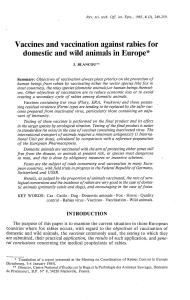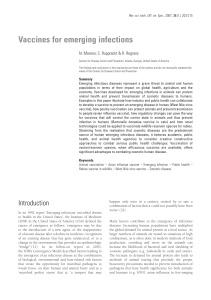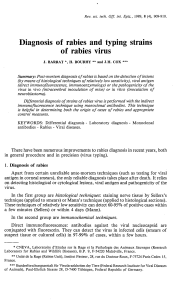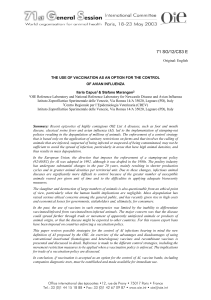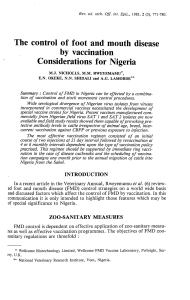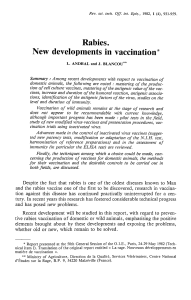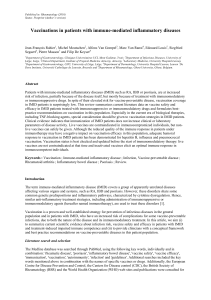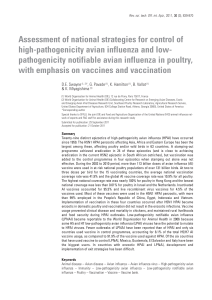D4021.PDF
publicité
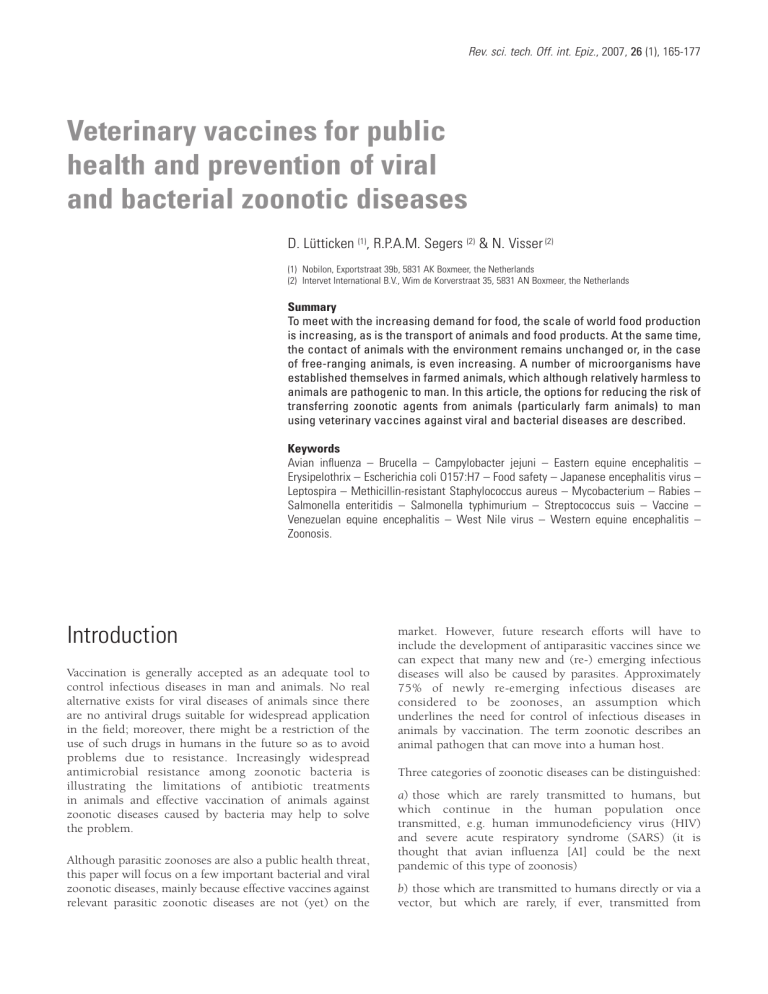
Rev. sci. tech. Off. int. Epiz., 2007, 26 (1), 165-177 Veterinary vaccines for public health and prevention of viral and bacterial zoonotic diseases D. Lütticken (1), R.P.A.M. Segers (2) & N. Visser (2) (1) Nobilon, Exportstraat 39b, 5831 AK Boxmeer, the Netherlands (2) Intervet International B.V., Wim de Korverstraat 35, 5831 AN Boxmeer, the Netherlands Summary To meet with the increasing demand for food, the scale of world food production is increasing, as is the transport of animals and food products. At the same time, the contact of animals with the environment remains unchanged or, in the case of free-ranging animals, is even increasing. A number of microorganisms have established themselves in farmed animals, which although relatively harmless to animals are pathogenic to man. In this article, the options for reducing the risk of transferring zoonotic agents from animals (particularly farm animals) to man using veterinary vaccines against viral and bacterial diseases are described. Keywords Avian influenza – Brucella – Campylobacter jejuni – Eastern equine encephalitis – Erysipelothrix – Escherichia coli O157:H7 – Food safety – Japanese encephalitis virus – Leptospira – Methicillin-resistant Staphylococcus aureus – Mycobacterium – Rabies – Salmonella enteritidis – Salmonella typhimurium – Streptococcus suis – Vaccine – Venezuelan equine encephalitis – West Nile virus – Western equine encephalitis – Zoonosis. Introduction Vaccination is generally accepted as an adequate tool to control infectious diseases in man and animals. No real alternative exists for viral diseases of animals since there are no antiviral drugs suitable for widespread application in the field; moreover, there might be a restriction of the use of such drugs in humans in the future so as to avoid problems due to resistance. Increasingly widespread antimicrobial resistance among zoonotic bacteria is illustrating the limitations of antibiotic treatments in animals and effective vaccination of animals against zoonotic diseases caused by bacteria may help to solve the problem. Although parasitic zoonoses are also a public health threat, this paper will focus on a few important bacterial and viral zoonotic diseases, mainly because effective vaccines against relevant parasitic zoonotic diseases are not (yet) on the market. However, future research efforts will have to include the development of antiparasitic vaccines since we can expect that many new and (re-) emerging infectious diseases will also be caused by parasites. Approximately 75% of newly re-emerging infectious diseases are considered to be zoonoses, an assumption which underlines the need for control of infectious diseases in animals by vaccination. The term zoonotic describes an animal pathogen that can move into a human host. Three categories of zoonotic diseases can be distinguished: a) those which are rarely transmitted to humans, but which continue in the human population once transmitted, e.g. human immunodeficiency virus (HIV) and severe acute respiratory syndrome (SARS) (it is thought that avian influenza [AI] could be the next pandemic of this type of zoonosis) b) those which are transmitted to humans directly or via a vector, but which are rarely, if ever, transmitted from 166 human to human, e.g. Lyme disease, West Nile virus infection, rabies (domestic or wild animal populations are the reservoirs for these pathogens) c) those which are transmitted by agents that cause little or no harm to the animal populations in which they have established themselves and which spread to humans through the consumption of food products, e.g. Campylobacter. Facts and factors which have favoured the re-emergence of zoonotic pathogens in the last decades are as follows: Rev. sci. tech. Off. int. Epiz., 26 (1) This paper does not intend to compete with those comprehensive publications written by experts in the field, but will rather try to highlight a selected number of zoonotic bacterial and viral diseases for which there are real opportunities to develop effective vaccines. The authors consider recent progress in areas such as biotechnology, and assess whether these areas of research can be used to develop improved vaccines that will help meet the target of preventing human disease by vaccination of animals. The paper ends with some recommendations for future research needs and a few general conclusions. – increasing human population expanding into new areas – a change in the behaviour of humans, including frequent and long-distance travel Bacterial diseases – globalisation of trade (for animal products) – movement of wild and domestic animals over long distances – climate change that has allowed pathogens and vectors to survive in new areas. In the past, vaccines for animals have mainly been developed to protect animal health and to increase animal welfare by preventing suffering as a result of infectious disease, but now, the damage inflicted by some highly contagious animal diseases on national and regional economies is an important driving force behind the implementation of vaccination programmes against zoonotic diseases. Slaughter policies are sometimes introduced to limit economic losses, as has been the case for some of the diseases listed by the World Organisation for Animal Health (OIE), but the authors believe that public opinion in most countries will not accept a stamping out policy in the future and it is the task of scientists to present alternatives, such as very efficient marker vaccines, to the decision-makers. Vaccines against zoonotic diseases should meet high standards so that veterinary authorities can prevent transmission of the disease to humans. Protecting the human population by vaccination of domestic (or wild) animals requires a collaborative effort from veterinarians, epidemiologists, human doctors and politicians. Significant scientific progress has been made by vaccinologists and epidemiologists, such as in designing models to calculate transmission rates (e.g. R-value [36, 37]) in animal populations. Tailor-made vaccination programmes can be designed, based on new technologies and know-how. Strategies to control zoonoses have been developed in recent years by many organisations. Through various symposia the OIE has published proposals for implementation on a worldwide scale, and in Europe, the European Food Safety Authority has produced guidelines, scientific reports and expert reports in the field of foodborne diseases (65). Campylobacter jejuni Campylobacter jejuni is the major cause of human foodpoisoning in most countries (1) and also causes immunemediated diseases such as the Guillain-Barré (87) and Miller-Fisher syndromes (56). Most human infections with these bacteria are associated with the consumption of poultry, but pets can also be a source of infection (22). The bacterium is very well adapted to chickens, and has a very low infectious dose. The majority of flocks are heavily and persistently colonised with up to 1010 colony forming units per gram of faeces without causing any problems for the chickens. Furthermore, C. jejuni is naturally competent and incorporates heterologous deoxyribonucleic acid (DNA) and is therefore genetically and antigenically heterogeneous. Although this is a complicating factor, the lack of pathogenic interaction with the host is the main reason why it has proven difficult to develop a reliable vaccine. Many types of live and inactivated vaccines have been tested, but without resulting in a practical solution. Some effect has been demonstrated with intraperitoneal vaccinations with whole cell bacterins and flagellins (82) as well as with a live Salmonella typhimurium vector containing a C. jejuni antigen (86). Although the bacterium is highly sensitive to specific serum antibodies, colonisation is not prevented by high levels of humoral antibodies as these do not reach the gut. Furthermore, live ‘vaccination’ with wild-type Campylobacter in young chicks (or even in-ovo) does not result in a reaction beyond what is normally found during colonisation and therefore does not result in a reliable reduction of colonisation. So far, the most efficient way to prevent transmission to man is to treat the meat after slaughter (e.g. by freezing) and to implement rigorous kitchen hygiene (30). A vaccine for human use would be another practical solution. Salmonella Salmonella typhimurium and S. enteritidis are the second most common cause of human food-poisoning, but they 167 Rev. sci. tech. Off. int. Epiz., 26 (1) occur mostly asymptomatically in livestock. For poultry, various inactivated (84) and live vaccines based on either or both of the S. typhimurium or S. enteritidis antigens are commercially available (5, 34). Also, live vaccination with attenuated S. gallinarum, which is a strict poultry pathogen has been shown to reduce S. enteritidis colonisation levels in chickens (28). Salmonella typhimurium infections in swine are mostly subclinical, but are an occupational hazard for pig farmers and can be transferred by meat products. Several vaccination strategies have been shown to be effective, e.g. sow vaccination with inactivated bacterins (62) and live vaccination of piglets with homologous (61) or heterologous serotypes (45). Vaccination is considered to be one of the cornerstones of the strategy to reduce human Salmonella infections. In 2003, the European Union issued Directive 2003/99/EC on the monitoring of zoonoses and zoonotic agents and Regulation (EC) No. 2160/2003 on the control of salmonella and other specified food-borne zoonotic agents. Salmonella in poultry is the first priority and from 2008 onwards, vaccination will be mandatory in Member States with an S. enteritidis prevalence of above 10% in layers. Further measures are expected for breeders and for swine in the near future. Escherichia coli Enterohaemorrhagic shigatoxin-producing Escherichia coli (EHEC) O157:H7 is present in the gut and faeces and on the skin of healthy cattle and sheep. The organism is very well adapted to the host and there is no evidence of pathogenic interactions. The organism can survive for several months in the soil (8). Transmission is mostly via food, notably ground/minced beef and raw milk (58), but the bacterium can also persist on lettuce and other produce after dung from infected animals has been used as fertiliser (69). Human outbreaks are often associated with haemolytic uraemic syndrome. Various pre- and postharvest interventions have been tested in feedlots (9). In the United States of America (USA), the incidence of O157:H7 outbreaks is slowly declining, possibly due to the many hygiene measures which have started to be taken (e.g. washing carcasses after slaughter). Recently, a subunit vaccine containing secreted virulence factors has been tested in field trials in feedlot cattle with variable results (24, 57). In a number of cases, the colonisation level of cattle was reduced but the result was still far from the desired sterile immunity. Clearly, vaccination could be an aid in further reducing the number of outbreaks, but only in combination with hygiene measures. Bovine tuberculosis Before pasteurisation of milk was introduced, bovine tuberculosis (TB), due to Mycobacterium bovis, caused 2000 deaths per annum in the United Kingdom (UK) alone. In addition, there was considerable economic damage to the cattle industry. The bacterium is still prevalent in cattle and wildlife in many developing countries, and is re-emerging in the UK, Ireland and New Zealand. There is controversy over whether vaccination or culling of wildlife would contribute to a reduction in M. bovis infection in cattle (49). Protection from infection can be achieved by vaccinating young animals with bacillus Calmette-Guérin (BCG) vaccine (12); however, this vaccination interferes with the tuberculin test and is therefore not compatible with the current TB surveillance programmes in cattle. Reviews of the efforts to develop TB vaccines and diagnostics have been published recently (33, 78). Paratuberculosis Mycobacterium avium subsp. paratuberculosis (MAP) is the causative agent of Johne’s disease in cattle and sheep, but there is still some controversy as to whether this organism is the causative agent of Crohn’s disease in humans (66). There is a long tradition of vaccination against Johne’s disease, especially with inactivated BCG, which can both prevent clinical disease and reduce shedding (26). An inactivated ovine vaccine is available commercially in a number of countries (59). However, use of this vaccine interferes with the tuberculin test used in M. bovis control programmes. Furthermore, it causes serious injury in humans if there is accidental self-injection (83). Live attenuated MAP vaccines are also available commercially (6), but these also interfere with the diagnostics of the TB control programmes. Recently, promising results have been obtained with a recombinant subunit vaccine (40). The common theme in (para)tuberculosis control is that the existing vaccines are not fully protective, cause safety problems at the injection site and induce a positive tuberculin test reaction. A lot of effort is therefore being invested into either setting up differential diagnostic tests that would allow the use of BCG-type vaccines in countries with a TB eradication programme or alternatively (and ideally) developing a better and safer subunit vaccine. However, progress is slow since, due to the nature of the infection, vaccine trials in cattle take approximately two years and require a lot of resources. Therefore, such a vaccine will take considerably more time to develop. Streptococcus suis Streptococcus suis is a known zoonotic agent and an occupational hazard for workers in the pork industry, mostly occurring as isolated cases of meningitis (4). Recently, 52 people died, mostly from streptococcal toxic shock syndrome during two outbreaks involving 168 serotype 2 in the People’s Republic of China (74). Asymptomatic nasopharyngeal carriage is often found in healthy swine, but can also cause fatal sepsis associated with meningitis and polyarthritis in swine of all ages (70). A total of 35 serotypes have been described, of which serotypes 2, 7 and 9 are (in that order) the most prevalent. In the pig industry, sows on problem farms with high piglet mortality (and sometimes high mortality in older swine as well) are vaccinated with inactivated auto-vaccines. After vaccination of sows with formalin-inactivated bacterin of serotype 2, high protection of the offspring against experimental challenge with the same serotype is observed (52). The species is genetically diverse and contains a number of putative virulence factors (e.g. suilysin, muramidase-released protein, extra-cellular factor, fibronectin-binding protein), but these neither seem to be absolutely conserved across the species S. suis nor necessary for virulence. So far, no cross-protective vaccine based on these antigens is available. Staphylococcus aureus Staphylococcus aureus is most known in the veterinary field as the causative agent of mastitis in dairy cattle. Sporadic cases exist where human infections have been linked to cases of bovine mastitis and MRSA [methicillin-resistant Staphylococcus aureus] strains have been isolated from cattle (43). However, in general, bovine mastitis strains are genetically different from human isolates (41, 88). Swine can be a source of S. aureus infection and in the Netherlands, pig breeders were identified recently as a group with an increased risk of being MRSA carriers. In cases of hospitalisation, they are kept isolated from other patients until proven negative (76). Furthermore, MRSA strains have also been isolated from chickens (43). Further research is necessary to determine whether poultry and swine are sources, or accidental recipients, of MRSA. Brucellosis Brucella infections in livestock result in abortions, weak offspring and long-term fertility problems. The three most pathogenic species for man are B. abortus, B. melitensis and B. suis, which have a host preference for cattle, smaller ruminants, and swine, respectively. However, they also infect other species of domestic animals as well as wildlife. Human infection usually occurs by direct contact with (aerosols from) amniotic fluids or unpasteurised milk. Since cellular immunity is required for long-term protection, the best results have been obtained with liveattenuated vaccines (54). Strain 19 has been used for vaccination against B. abortus since 1941. Since it is a smooth strain and interferes with Brucella serological Rev. sci. tech. Off. int. Epiz., 26 (1) diagnostic tests, it is mostly given at a young age. By the time the animals enter their reproductive stage the serological response has disappeared but lifelong protection remains. The vaccine also works in herds of adult animals, but lower doses are used to prevent abortion and interference with serological diagnostic tests. More recently, the rough strain RB51 with reduced O-antigen expression was developed and has been used in the USA since 1996. It has a slightly lower protective effect than strain 19, but it does not interfere with serological diagnostics and it can be used at higher doses in pregnant cattle. For vaccination against B. melitensis, strain Rev1 is the most successful in small ruminants. For B. suis no commercial vaccines are available and none of the other Brucella vaccines give significant cross-protection. Generally speaking, none of the available Brucella vaccines give sterile protection and successful brucellosis control programmes use hygiene measures and stamping out protocols as well. Leptospirosis The most prevalent human leptospiral diseases (e.g. Weil’s disease) are caused by contamination of surface water by leptospiruric rodents. This route of infection cannot be controlled by vaccination. However, both Leptospira borgpetersenii serovar hardjo (type hardjobovis) and L. interrogans serovar hardjo (type hardjoprajitno) infect dairy cattle and can cause milk drop syndrome and fertility problems (25). After renal colonisation, animals shed the bacteria in the urine and can infect farmers by the ocular route in the milking parlour. Commercially available vaccines containing inactivated whole cell bacteria can protect cattle from renal colonisation and urinary shedding and thus protect farmers from this occupational health hazard (7). Erysipelothrix rhusiopathiae This bacterium is known to cause erysipelas in pigs and poultry (11). Erysipelothrix rhusiopathiae infection is an occupational hazard for pig farmers, veterinarians and slaughterhouse workers. Most human infections are mild and cutaneous, but systemic infections with associated endocarditis have also been reported. The bacterium can be isolated from almost all farms and can survive for a long time in the environment. Vaccination against erysipelas is common practice in the pig industry and many efficacious vaccines are available. Viral diseases Among the many animal viral infections known to also infect humans, there is a large variation in the degree of 169 Rev. sci. tech. Off. int. Epiz., 26 (1) human suffering ranging, for instance, from the mild conjunctivitis caused by Newcastle disease virus (NDV) of poultry to the inevitable lethal outcome of symptomatic rabies transferred by the bite or scratch of a rabies virusinfected animal. The scope of this section is limited to preventable viral diseases of economic or social importance, as listed in Table I. For newly emerging viral infections, such as hantavirus or SARS, there are as yet no veterinary vaccines. Table I Vaccination against viral zoonoses of economic or social importance Lethal disease in humans Vaccinated vectors Unvaccinated vectors Rabies Dogs, cats, wildlife Bats (Avian) influenza Poultry, swine Wild birds Viral encephalitis Equines, swine Wild birds Severe acute respiratory syndrome None* Bat, civet cat Hantavirus disease None* Rodents *For these diseases there is currently no practical method of administering vaccines to wildlife vectors Rabies Rabies virus infection invariably results in a fatal outcome in humans and a great variety of other mammals. That rabies infected animals are a threat for human beings has been known for centuries. Only when, more than a century ago, the concept of vaccination became available through the pioneering work of Pasteur, could this disease be treated or prevented. Even post-infection treatment is possible; rabies being probably the only virus infection where post-exposure vaccination is effective. Most of the human rabies cases are located in Asia, especially India (22,000 to 30,000 fatalities per annum) (73, 85), and in Africa (24,000 fatalities per annum) (85). Moreover, it is very likely that the numbers are higher than this, as there appears to be substantial underreporting, perhaps as much as tenfold to a hundredfold (19, 20). In African and Asian countries rabies is a disease of poverty. It particularly affects children under the age of fifteen, because they do not always recognise changes in the behaviour of infected dogs, are more playful and often completely unaware of the danger posed by rabid dogs. Educating and creating awareness are therefore instrumental in the fight against rabies. Unfortunately, there are a number of reasons why rabies in dogs is not getting the attention that it deserves in these countries: – the disease has been present for hundreds of years and is considered a fact of life, so it does not have much publicity value or receive political attention – dogs have no ‘governmental status’; there is no clear ministerial responsibility – a combination of population control and vaccination (parenteral and oral) can substantially decrease the burden of endemic rabies in dogs, but the priority is protecting human health, so greater emphasis is given to controlling, rather than vaccinating, the dog population (73). Vaccination strategies In many countries programmes are in place to control rabies in domestic dogs and wildlife. The programmes are enforced by governmental campaigns for the vaccination of all dogs or by the existence of a law that allows border crossing only if it can be shown that a domestic carnivore (dog, cat or ferret) has the minimal antibody titre against rabies, i.e. ≥ 0.5 IU. A lot of effort has been put into the eradication of rabies from wildlife such as European foxes (21, 63) and programmes are continuing, particularly in Eastern Europe (67). Along the same lines, oral vaccination programmes are in place in Canada and the USA, where raccoons and skunks are the main targets for vaccination (17). Bats cannot be vaccinated and rabid bats cause several fatal human cases each year. Significant progress has been made as a result of vaccination programmes for companion animals, as can be seen by the data provided on the website of the Rabies Center at the Centers for Disease Control in Atlanta in the USA (17). There has been a tenfold decrease in the number of rabies cases in companion animals from 1955 to 1975, which has been maintained to date. However, the number of wildlife cases per annum has increased since 1975. The use of oral vaccines now plays a key role in diminishing the prevalence of rabies in the field (3). Parenteral vaccination of companion animals (carnivores) Initially, mouse or sheep brain vaccines were produced for preventive vaccination. However, these vaccines came with a number of side-reactions that limited their use. It was the development of cell culture vaccines, mainly based on baby hamster kidney (BHK) cells that played a crucial role in the increased parenteral vaccination of companion animals and this led to a dramatic decrease in the number of human exposures. Now, in addition to this parenteral vaccination approach, oral vaccination of dogs is receiving more and more attention (85). In Latin America, yearly vaccination campaigns have been very effective and have reached up to 90% or more of the 170 dog population (18). Instrumental in this achievement was the realisation that often dogs are not covered by a ministerial department; they do not fall within the scope of the Ministry of (Human) Health, nor were they considered to be under the remit of the Departments of Agriculture, Wildlife or the Environment: they were nobody’s responsibility. Anecdotally, it was therefore decided to confine the Ministers of all three Departments in one room and not allow them to leave until the responsibility was clarified. It was decided that the Department of Human Health should take the responsibility, and, as a result, there is now a very effective yearly vaccination programme in Latin America that involves vaccinating millions of dogs in only a few days. Oral vaccination of wildlife and stray dogs The large-scale use of oral vaccine baits started in Switzerland with the pioneering work of Steck and Wandeler (71, 72). Their use of an attenuated strain of rabies (SAD-strain) given as a liquid in a plastic container, hidden in a chicken head obtained from the local slaughterhouse, was tremendously effective in foxes. The baits were spread in rural areas and woods by hunters or dropped from planes and helicopters. By using natural barriers, one area after another was cleared of rabies. After the successful start in Switzerland, many other European countries followed (10, 21, 51, 63, 67). The situation is remarkably different in developing countries in Asia, the Middle East and Africa, where vaccination reaches only a very small part of the dog population. Here, as in other areas of the world, dogs are the major intermediate in human rabies cases, and freeroaming stray (ownerless) dogs are the endemic reservoir for the virus. Oral vaccination is without doubt the single most effective measure for combating rabies in stray dogs, especially since the implementation of recombinant DNA technology, which has allowed the development of vaccines with greatly improved safety and efficacy (23, 29, 38, 47). Rev. sci. tech. Off. int. Epiz., 26 (1) markets for the increasing risk of avian virus transmission to humans has also recently been investigated (80). Although initially the reassortment of influenza viruses in pigs was regarded as the major source of new pathogenic human influenza viruses, we now know that the greater risk comes from the mutation or recombination of aquatic poultry viruses. Intensive (commercial) poultry farming forms an important ‘in between’ step in the transmission of highly pathogenic avian viruses to humans. It has been postulated that vaccination of domestic poultry could accelerate the antigenic drift of AI viruses (42). However, recent success in the application of the DIVA [Differentiation between Infected and Vaccinated Animals] principle based on a differentiating vaccine with a heterologous neuraminidase, in the control of avian influenza in the field shows the potential of vaccination for the reduction of virus transmission (14). In another article in this issue of the Review, I. Capua gives a detailed report on a relevant field case. More recent laboratory studies (32) have proven that vaccination of chickens with a conventional inactivated vaccine can completely prevent the spread of a highly pathogenic AI virus to susceptible in-contact birds. The potential of using highly effective live vector vaccines (e.g. the NDV vaccine [77]) as marker vaccines in the field should be tested to evaluate all of the available options to minimise the risk of bird to human transmission of influenza viruses. The impact of vaccination of chickens on animal, particularly poultry, health has been proven and the recent progress means that we can state that an optimal vaccination strategy for domestic poultry will prevent transmission of influenza viruses from poultry to man. Scientists should make use of modern tools like epitope analysis (50) and bioinformatics (44) for rational vaccine design to develop an optimal vaccination strategy for poultry vaccination with the aim of preventing transmission of pathogenic influenza viruses from domestic poultry to humans. Influenza and avian influenza Influenza can best be defined as a re-emerging zoonotic infectious disease, and there is a worldwide fear of an upcoming pandemic among the human population caused by transmission of avian viruses belonging to the H5, H7 and H9 subtypes (2, 16). In a recent review by Webster and Hulse (81) the factors for the evolution of the virus are described. Not surprisingly, these factors include the increasing population densities of poultry, swine, and humans, as mentioned for zoonosis emergence in general in the introductory section of this paper. The importance of wet Encephalitides transmitted by mosquitoes A number of viral zoonoses that cause severe, sometimes lethal, infections in humans are transmitted by mosquitoes. One group of viruses belonging to the family of Togaviridae is the so-called Group A arboviruses (arthropod-borne viruses), commonly called alphaviruses. These include Venezuelan equine encephalomyelitis virus (VEE), Western equine encephalomyelitis virus (WEE) and Eastern equine encephalomyelitis virus (EEE). All of them infect the brain and the spinal cord of the host, as is reflected in the names (15, 31). 171 Rev. sci. tech. Off. int. Epiz., 26 (1) Two other strains of encephalitis-causing viruses belong to the family Flaviviridae. They are also transmitted by mosquitoes and can cause encephalitis in man and equines. They belong to the Group B arboviruses and are generally called flaviviruses. The relevant virus species here are Japanese encephalitis virus (JEV) and West Nile virus (WNV). Initially, the clinical signs are flu-like symptoms, later on, as the infection affects neuronal cells, behavioural changes similar to rabies infection are seen. Because of its neurological symptoms the disease is also called sleeping sickness. Vaccination of equines is practised for all of the viruses described here and in addition, in the case of JEV, vaccination of swine is performed. Preventive vaccination is principally undertaken for economic reasons, although for people working daily with horses in infected areas, or with swine in the case of JEV, the additional benefit is that the exposure pressure for humans will certainly also be reduced (35). However, the most practical prevention for humans is to avoid mosquito bites, by, for instance, the use of a good insect repellent. See Table II for an overview of the encephalitis viruses and the vaccine types in use. virus variants the efficacy of VEE vaccination is not always optimal. Eastern equine encephalomyelitis virus As its name indicates EEE is mainly found in the Eastern part of the USA. Of all the encephalitis viruses it is EEE that affects humans most severely; as much as 30% of the infections by EEE virus are lethal. In equines it is even more pronounced and the infection may lead to mortality in as many as 90% of cases (48). Several brands of inactivated vaccines are available for use in equines, often combined with WEE and VEE as a trivalent vaccine. Western equine encephalomyelitis virus The ‘western’ name is derived from its presence mainly in the western part of the USA. The clinical signs in humans and horses are usually worse than with VEE but less severe than with EEE. Still, some 3% to 10% of the human cases are ultimately fatal (60). Vaccination of horses is practiced mostly using the trivalent vaccine as mentioned above. Venezuelan equine encephalomyelitis virus The VEE virus caused devastating epidemics in the 1960s and 1970s in Middle and South America where thousands of horses died (79). The outbreaks were finally stopped by the administration of a live attenuated vaccine (39). Today, various inactivated vaccines are also available. There is no direct spread from horse to horse or from horse to man; the transfer of the virus is always by insect. The endemic reservoir is wild birds; no specific species has been clearly identified yet. The infection of humans is mostly mild; however, more severe cases of encephalitis have been reported. Due to strain differences between the vaccine and the various field Japanese encephalitis virus Japanese encephalitis virus belongs to the flavivirus group and its greatest economic impact is on the pig industry in Southeast Asia. The mortality both in swine and equines can be as high as 50% in endemic areas. The same is true in humans, and people that recover often suffer from permanent neurological problems (27). Live attenuated and inactivated vaccines are available for swine (53, 75). Horses are also vaccinated to a limited extent. A vaccine developed in Japan for human use is also licensed in the USA; using this vaccine is probably the most effective way to protect humans. As with the other encephalitis viruses, the reservoir is wild birds. Table II Vaccination against encephalitis viruses (principally undertaken for economic reasons) In the ‘natural reservoir’ column the bird species that is considered to contribute most to the maintenance of the infection is given in brackets Family Genus Virus Affected domestic Type of vaccine species Wild reservoir Insect vector Togaviridae Alphavirus Venezuelan equine encephalomyelitis virus Equines Live attenuated, inactivated Wild birds Mosquitoes, black fly Western equine encephalomyelitis virus Equines, pheasants Inactivated Wild birds (Passerine) Mosquitoes, tick Eastern equine encephalomyelitis virus Equines, pheasants Inactivated Wild birds (Water fowl) Mosquitoes Wild birds (Heron, Egret)* Culex species Flaviviridae Flavivirus Japanese encephalitis virus Swine, equines Live attenuated, inactivated West Nile fever virus Equines Live, vector, inactivated, DNA Wild birds *In the case of Japanese encephalitis virus swine are also considered to be a reservoir Culex species 172 West Nile fever virus West Nile fever virus is one of the more recent emerging zoonotic viruses. It was first observed sporadically in Africa, Israel and Eastern Europe, and more recently (in 1999) a large epizootic occurred in the USA (46, 55, 68). A relatively large percentage of infected individuals (approximately 10% of humans and 30% of equines) do not survive the infection (13, 15). The 1999 outbreak of West Nile fever triggered a lot of developments in modern approaches to vaccines against equine encephalitis virus infections. This has already led to the licensing of a West Nile DNA-based vaccine. In addition, the use of a live vector that expresses a viral glycoprotein essential for protective immunity against the encephalitis virus has been receiving great attention. A canary-pox vector vaccine is available, and chimeric vaccines based on the yellow fever 17D strain are in a very advanced stage of development for both human and veterinary use (64). In addition, subunit vaccines, based on antigens produced by baculo, yeast or E. coli expression systems, are being explored. Conclusion/recommendations Development of vaccination strategies against zoonotic infectious diseases requires a collaborative effort of human and veterinary vaccinologists if the programme is to serve animal and human welfare. Recent progress in molecular biology and immunology allows the design of tailor-made vaccines which can meet the specific requirements for each vaccine/disease. In general terms, modern vaccines against infectious animal diseases should be marker vaccines, they should be mass applicable and the relevant protective immune response should be measurable by an in vitro test system. Of the viral diseases reviewed in this article rabies and avian influenza are perhaps the most important in terms of the impact the development of an animal vaccine could have on protecting humans. If based on the available Rev. sci. tech. Off. int. Epiz., 26 (1) epidemiological knowledge, a vaccination scheme for stray dogs using a safe rabies vaccine strain administered orally could save many lives in Asia, the Middle East and Africa. For avian influenza, use of a mass applicable vaccine could eventually replace the relatively expensive injectable products if the same efficacy could be achieved. Further research is required by epidemiologists and vaccinologists to design tailor-made vaccination programmes for the various husbandry systems of the poultry industry. For food-borne diseases, various Salmonella vaccines have been shown to be effective in reducing transmission through animal-derived products. Tools and data are available to develop prophylactic programmes. More research is required to develop a complementary vaccination/sanitation programme to protect man from E. coli infection. A marker vaccine which will not interfere with the current diagnostic procedures in vaccine recipients will certainly help in controlling bovine TB. Alternatively, the development of a more specific diagnostic method to replace the current skin test, will allow the development of both live and killed whole-cell based vaccines. The authors believe that tools and candidate vaccines to develop effective prevention programmes for most diseases are available, but targeted efforts are required to create specific programmes for each disease. Acknowledgements The skilful typing of Mrs. Irene Verbeek and the language skills of Dr Linda Horspool were greatly appreciated during the writing of this manuscript. 173 Rev. sci. tech. Off. int. Epiz., 26 (1) Les vaccins vétérinaires en santé publique et la prévention des zoonoses virales et bactériennes D. Lütticken, R.P.A.M. Segers & N. Visser Résumé Face à une demande toujours accrue, la quantité de denrées alimentaires produites au niveau mondial ne cesse d’augmenter, de même que les capacités de transport d’animaux et de produits alimentaires. En même temps, les contacts entre les animaux et leur environnement restent inchangés, voire, dans le cas des animaux vivant en liberté, se multiplient. Certains microorganismes désormais bien établis chez les animaux d’élevage et relativement inoffensifs pour l’animal sont dangereux pour l’homme. Les auteurs décrivent les différentes options envisageables pour réduire le risque de transfert à l’homme des agents pathogènes zoonotiques d’origine animale (en particulier ceux qui affectent les animaux d’élevage), au moyen de vaccins vétérinaires dirigés contre les maladies virales et bactériennes. Mots-clés Brucella – Campylobacter jejuni – Encéphalomyélite équine de l’Est – Encéphalomyélite équine de l’Ouest – Encéphalomyélite équine vénézuélienne – Erysipelothrix – Escherichia coli O157:H7 – Influenza aviaire – Leptospira – Mycobacterium – Rage – Salmonella enteritidis – Salmonella typhimurium – Sécurité sanitaire des aliments – Staphylococcus aureus résistant à la méthicilline – Streptococcus suis – Vaccin – Virus de l’encéphalite japonaise – Virus West Nile – Zoonose. Vacunas veterinarias para la salud pública y prevención de enfermedades zoonóticas virales y bacterianas D. Lütticken, R.P.A.M. Segers & N. Visser Resumen Para satisfacer la creciente demanda de alimentos, el volumen de su producción mundial, así como del transporte de animales y productos alimentarios, se está incrementando. Simultáneamente, el contacto de los animales con su entorno no ha cambiado o, en el caso de animales criados en libertad, incluso aumenta. Algunos microorganismos que se han establecido en los criaderos son relativamente inocuos para los animales, pero tienen una acción patógena en los seres humanos. En este artículo se describen las opciones para reducir el riesgo de la transferencia de agentes zoonóticos de los animales (en particular, los de criadero) a los seres humanos mediante su vacunación contra las enfermedades virales y bacterianas. Palabras clave Brucella – Campylobacter jejuni – Encefalomielitis equina del Este – Encefalomielitis equina del Oeste – Encefalomielitis equina venezolana – Erysipelothrix – Escherichia coli O157:H7 – Estafilococo áureo resistente a la meticilina – Influenza aviar – Inocuidad de los alimentos – Leptospira – Mycobacterium – Rabia – Salmonella enteritidis – Salmonella typhimurium – Streptococcus suis – Vacuna – Virus de la encefalitis japonesa – Virus del Nilo occidental – Zoonosis. 174 Rev. sci. tech. Off. int. Epiz., 26 (1) References 1. Allos B.M. (2001). – Campylobacter jejuni infections: update on emerging issues and trends. Clin. infect. Dis., 32 (8), 12011206. 2. Anon. (2006). – Avian influenza vaccine information website. Available at: www.avian-influenza.com (accessed, September 2006). 3. Anon. (2006). – Rabies vaccine information. Available at: http://www.rabies-vaccination.com (accessed, September 2006). 4. Arends J.P. & Zanen H.C. (1988). – Meningitis caused by Streptococcus suis in humans. Rev. infect. Dis., 10, 131-137. 5. Barrow P.A., Mead G.C., Wray C. & Duchet-Suchaux M. (2003). – Control of food-poisoning salmonella in poultry: biological options. World Poult. Sci. J., 59 (3), 373-383. 6. Begg D.J. & Griffin J.F.T. (2005). – Vaccination of sheep against M. paratuberculosis: immune parameters and protective efficacy. Vaccine, 23 (42), 4999-5008. 7. Bolin C.A. & Alt D.P. (2001). – Use of a monovalent leptospiral vaccine to prevent renal colonization and urinary shedding in cattle exposed to Leptospira borgpetersenii serovar hardjo. Am. J. vet. Res., 62 (7), 995-1000. 8. Bolton D.J., Byrne C.M., Sheridan J.J., McDowell D.A. & Blair I.S. (1999). – The survival characteristics of a nontoxigenic strain of Escherichia coli O157:H7. J. appl. Microbiol., 86 (3), 407-411. 9. Brabban A.D., Nelsen D.A., Kutter E., Edrington T.S. & Callaway T.R. (2004). – Approaches to controlling Escherichia coli O157:H7, a foodborne pathogen and an emerging environmental hazard. Environ. Pract., 6 (3), 208-229. 10. Brochier B., Kieny M.P., Costy F., Coppens P., Bauduin B., Lecocq J.P., Languet B., Chappuis G., Desmettre P., Afiademanyo K., Libois R. & Pastoret P.-P. (1991). – Large scale eradication of rabies using recombinant vaccinia-rabies vaccine. Nature, 354, 520-522. 11. Brooke C.J. & Riley T.V. (1999). – Erysipelothrix rhusiopathiae: bacteriology, epidemiology and clinical manifestations of an occupational pathogen. J. med. Microbiol., 48 (9), 789-799. 12. Buddle B.M., Wedlock D.N., Parlane N.A., Corner L.A.L., De Lisle G.W. & Skinner M.A. (2003). – Revaccination of neonatal calves with Mycobacterium bovis BCG reduces the level of protection against bovine tuberculosis induced by a single vaccination. Infect. Immun., 71 (11), 6411-6419. 13. Bunning M.L., Wilson T.M. & Bowen R.A. (2004). – West Nile virus infections. In Infectious diseases of livestock, Vol. 2, 2nd Ed. (J.A.W. Croetzer & R.C. Tustin, eds). Oxford Press South Africa, 1009-1011. 14. Capua I., Terregino C., Cattoli G., Mutinelli F. & Rodriguez J.F. (2003). – Development of DIVA strategy using a vaccine containing a heterologous neuraminidase for the control of avian influenza. Avian Pathol., 32, 47-55. 15. Centers for Disease Control and Prevention (CDC) (2006). – Arboviral encephalitides, CDC, Atlanta, USA. Available at: http://www.cdc.gov/ncidod/dvbid/arbor/index.htm (accessed, September 2006). 16. Centers for Disease Control and Prevention (CDC) (2006). – Avian influenza, CDC, Atlanta, USA. Available at: http://www.cdc.gov/flu/avian/gen-info/avian-influenza. htm (accessed, September 2006). 17. Centers for Disease Control and Prevention (CDC) (2006). – Rabies disease and control, CDC, Atlanta, USA. Available at: http://www.cdc.gov/ncidod/dvrd/rabies/introduction/ intro.htm (accessed, September 2006). 18. Chomel B., Chappuis G., Bullon F., Cardenas R., David de Beublain T., Maufrais M.C. & Giambruno E. (1987). – Serological results of a dog vaccination campaign against rabies in Peru. Rev. sci. tech. Off. int. Epiz., 6 (1), 97-113. 19. Cleaveland S., Fèvre E.M., Kaare M. & Coleman P.G. (2002). – Estimating human rabies mortality in the United Republic of Tanzania from dog bite injuries. Bull. WHO, 80 (4), 304310. 20. Cleaveland S., Kaare M., Tiringa P., Mlengeya T. & Barrat J. (2003). – A dog rabies vaccination campaign in rural Africa: impact on the incidence of dog rabies and human dog-bite injuries. Vaccine, 21, 1965-1973. 21. Cliquet F. & Aubert M. (2004). – Elimination of terrestrial rabies in western European countries. In Proc. Conference on Control of Infectious Animal Diseases by Vaccination (A. Schudel & M. Lombard, eds), 13-16 April, Buenos Aires. Dev. Biol. (Basel), 119, 185-204. 22. Damborg P., Olsen K.E.P., Nielsen E.M. & Guardabassi L. (2004). – Occurrence of Campylobacter jejuni in pets living with human patients infected with C. jejuni. J. clin. Microbiol., 42 (3), 1363-1364. 23. Dietzschold M.L., Faber M., Mattis J.A., Pak K.Y., Schnell M.J. & Dietzschold B. (2004). – In vitro growth and stability of recombinant rabies virus designed for vaccination of wildlife. Vaccines, 23, 518-524. 24. Donkersgoed J. van, Hancock D., Rogan D. & Potter A.A. (2005). – Escherichia coli O157:H7 vaccine field trial in 9 feedlots in Alberta and Saskatchewan. Can. vet. J., 46 (8), 724-728. 25. Ellis W.A., O’Brien J.J., Bryson D.G. & Mackie D.P. (1985). – Bovine leptospirosis: some clinical features of serovar hardjo infection. Vet. Rec., 117 (5), 101-104. Rev. sci. tech. Off. int. Epiz., 26 (1) 175 26. Emery D.L. & Whittington R.J. (2004). – An evaluation of mycophage therapy, chemotherapy and vaccination for control of Mycobacterium avium subsp. paratuberculosis infection. Vet. Microbiol., 104 (3-4), 143-155. 38. Kieny M.P., Lathe R., Drillien R., Spehner D., Skory S., Schmitt D., Wiktor T.J., Koprowski H. & LeCocq J.P. (1984). – Expression of rabies glycoprotein from a recombinant vaccinia virus. Nature, 312, 163-166. 27. Eny T.P. & Nisalak A. (2002). – Japanese encephalitis virus: ecology and epidemiology. Curr. Top. Microbiol. Immunol., 267, 11-48. 39. Kinney R.M., Johnson B.J., Welch J.B., Tsuchiya K.R. & Trent D.W. (1989). – The full-length nucleotide sequences of the virulent Trinidad donkey strain of Venezuelan equine encephalitis virus and its attenuated vaccine derivative, strain TC-83. Virology, 170, 19-30. 28. Feberwee A., De Vries T.S., Hartman E.G., De Wit J.J., Elbers A.R.W. & De Jong W.A. (2001). – Vaccination against Salmonella enteritidis in Dutch commercial layer flocks with a vaccine based on a live Salmonella gallinarum 9R strain: evaluation of efficacy, safety, and performance of serologic Salmonella tests. Avian Dis., 45 (1), 83-91. 29. Fekadu M., Nesby S.L., Shaddock J.H., Schumacher C.L., Linhart S.B. & Sanderlin D.W. (1996). – Immunogenicity, efficacy and safety of an oral rabies vaccine (SAG-2) in dogs. Vaccine, 4 (6), 465-468. 30. Georgsson F., Orkelsson A., Geirsdóttir M., Reiersen J. & Stern N.J. (2006). – The influence of freezing and duration of storage on Campylobacter and indicator bacteria in broiler carcasses. Food Microbiol., 23 (7), 677-683. 31. Gibbs E.P.J. (2004). – Equine encephalitides caused by alphaviruses. In Infectious diseases of livestock, Vol. 2, 2nd Ed. (J.A.W. Croetzer & R.C. Tustin, eds). Oxford Press South Africa, 1014-1022 32. Goot J.A. van der, Koch G., de Jong M.C.M. & van Boven M. (2005). – Quantification of the effect of vaccination on transmission of avian influenza (H7N7) in chickens. Proc. natl Acad. Sci. USA, 102 (50), 18141-18146. 33. Hogarth P.J., Hewinson R.G. & Vordermeier H.M. (2006). – Development of vaccines against bovine tuberculosis. J. Pharm. Pharmacol., 58 (6), 749-757. 34. Immerseel F. van, Methner U., Rychlik I., Nagy B., Velge P., Martin G., Foster N., Ducatelle R. & Barrow P.A. (2005). – Vaccination and early protection against non-host-specific Salmonella serotypes in poultry: Exploitation of innate immunity and microbial activity. Epidemiol. Infect., 133 (6), 959-978. 35. Jahrling P.B. & Stephenson E.H. (1984). – Protective efficacies of live attenuated and formaldehyde-inactivated Venezuelan equine encephalitis virus vaccines against aerosol challenge in hamsters. J. clin. Microbiol., 19, 429-431. 36. Jong M.C.M. de & Diekman O. (1992). – A method to calculate––for computer-simulated infections––the threshold value R0, that predicts whether or not the infection will spread. Prev. vet. Med. 12, 269-285. 37. Jong M.C.M. de & Kimman T.G. (1994). – Experimental quantification of vaccine-induced reduction in virus transmission. Vaccine Geirsdóttir, 12 (8), 761-766. 40. Koets A., Hoek A., Langelaar M., Overdijk M., Santema W., Franken P., Eden W.V. & Rutten V. (2006). – Mycobacterial 70 kD heat-shock protein is an effective subunit vaccine against bovine paratuberculosis. Vaccine, 24 (14), 2550-2559. 41. Larsen H.D., Huda A., Eriksen N.H.R. & Jensen N.E. (2000). – Differences between Danish bovine and human Staphylococcus aureus isolates in possession of superantigens. Vet. Microbiol., 76 (2), 153-162. 42. Lee C.W., Senne D.A. & Suarez D.L. (2004). – Effect of vaccine use in the evolution of Mexican lineage H5N2 avian influenza virus. J. Virol., 78 (15), 8372-8381. 43. Lee J.H. (2003). – Methicillin (Oxacillin)-resistant Staphylococcus aureus strains isolated from major food animals and their potential transmission to humans. Appl. environ. Microbiol., 69 (11), 6489-6494. 44. Lee M.S. & Chen J.S. (2004). – Predicting antigenic variants of influenza A/H3N2 viruses. Emerg. infect. Dis., 10 (8), 13851390. 45. Maes D., Gibson K., Trigo E., Saszak A., Grass J., Carlson A. & Blaha Th. (2001). – Evaluation of cross-protection afforded by a Salmonella Choleraesuis vaccine against Salmonella infections in pigs under field conditions. Berl. Münch. tierärztl. Wochenschr., 114 (9-10), 339-341. 46. Marfin A.A. & Gubler D.J. (2001). – West Nile encephalitis: an emerging disease in the United States. Clin. infect. Dis., 33 (10), 1713-1719. 47. Mebatsion T. (2001). – Extensive attenuation of rabies virus by simultaneously modifying the dynein light chain binding site in the P protein and replacing Arg333 in the G protein. J. Virol., 75 (23), 11496-11502. 48. Morris C.D. (1989). – Eastern equine encephalitis. In The arboviruses: epidemiology and ecology (T.P. Monath, ed.). Vol. 3, CRC Press, Boca Raton, 1-20. 49. Morrison W.I., Bourne F.J., Cox D.R., Donnelly C.A., Gettinby G., McInerney P.J. & Woodroffe R. (2004). – Potential use of vaccination in cattle or badgers to control bovine tuberculosis. In Proc. Conference on Control of Infectious Animal Diseases by Vaccination (A. Schudel & M. Lombard, eds), 13-16 April, Buenos Aires. Dev. Biol. (Basel), 119, 351-359. 50. Munoz E.T. & Deem M.W. (2005). – Epitope analysis for influenza vaccine design. Vaccine, 23 (9), 1144-1148. 176 51. Neubert A., Schuster P., Müller T., Vos A. & Pommerening E. (2001). – Immunogenicity and efficacy of the oral rabies vaccine SAD B19 in foxes. J. vet. Med., B, infect. Dis. vet. public Hlth, 48, 179-183. 52. Nielsen B., Bak H., Nell T., Jacobs A.A.C., Wijnhoven L.T.J. & Segers R.P.A.M. (2006). – Sow vaccination with Porcilis® Strepsuis and protection of the offspring against lethal challenge with Streptococcus suis serotype 2. In Proceedings of the 19th IPVS Congress, 16-19 July, Copenhagen, Denmark (J.P. Nielsen & S.J. Jorsal, eds), Abstract 18-07. Available at: http://www.ipvs2006.dk/restricted/ (accessed on 16 February 2007). 53. Nitayaphan S., Grant J.A., Chang G.J. & Trent D.W. (1990). – Nucleotide sequence of the virulent SA-14 strain of Japanese encephalitis virus and its attenuated vaccine derivative, SA-14-14-2. Virology, 177, 541-552. 54. Olsen S.C. & Stoffregen W.S. (2005). – Essential role of vaccines in brucellosis control and eradication programs for livestock. Expert Rev. Vaccines, 4 (6), 915-928. 55. Ostlund E.N., Crom R.L., Pedersen D.B., Johnson D.J., Williams W.O. & Schmitt B.J. (2001). – Equine West Nile encephalitis, United States. Emerg. infect. Dis., 7, 665-669. 56. Overall J.R. & Willison H.J. (2005). – Recent developments in Miller Fisher syndrome and related disorders. Curr. Op. Neurobiol., 18 (5), 562-566. 57. Potter A.A., Klashinsky S., Li Y., Frey E., Townsend H., Rogan D., Erickson G., Hinkley S., Klopfenstein T., Moxley R.A., Smith D.R. & Finlay B.B. (2004). – Decreased shedding of Escherichia coli O157:H7 by cattle following vaccination with type III secreted proteins. Vaccine, 22 (3-4), 362-369. 58. Rangel J.M., Sparling P.H., Crowe C., Griffin P.M. & Swerdlow D.L. (2005). – Epidemiology of Escherichia coli O157:H7 outbreaks, United States, 1982-2002. Emerg. infect. Dis., 11 (4), 603-609. 59. Reddacliff L., Eppleston J., Windsor P., Whittington R. & Jones S. (2006). – Efficacy of a killed vaccine for the control of paratuberculosis in Australian sheep flocks. 15 June. Vet. Microbiol., 115 (1-3), 77-90. 60. Reisen W.K. & Monath T.P. (1989). – Western equine encephalitis. In The arboviruses: epidemiology and ecology (T.P. Monath, ed.). Vol. 5, CRC Press, Boca Raton, 89-137. 61. Roesler U., Marg H., Schröder I., Mauer S., Arnold T., Lehmann J., Truyen U. & Hensel A. (2004). – Oral vaccination of pigs with an invasive gyrA-cpxA-rpoB Salmonella typhimurium mutant. Vaccine, 23 (5), 595-603. 62. Roesler U., Heller P., Waldmann K.-H., Truyen U. & Hensel A. (2006). – Immunization of sows in an integrated pig-breeding herd using a homologous inactivated Salmonella vaccine decreases the prevalence of Salmonella typhimurium infection in the offspring. J. vet. Med., B, infect. Dis. vet. public Hlth, 53 (5), 224-228. Rev. sci. tech. Off. int. Epiz., 26 (1) 63. Schneider L.G. & Cox J.H. (1983). – Ein Feldversuch zur oralen Immunisierung von Füchsen gegen die Tollwut in der Bundesrepublik Deutschland. Tierztl. Umschä., 38, 315-324. 64. Schoepp R.J., Smith J.F. & Parker M.D. (2000). – Recombinant chimeric Western and Eastern equine encephalitis viruses as potential vaccine candidates. Virology, 302, 299-309. 65. Schudel A. & Lombard M. (eds) (2004). – Proc. Conference on Control of infectious animal diseases by vaccination. Dev. Biol. (Basel), 119. 66. Shanahan F. & O’Mahony J. (2005). – The mycobacteria story in Crohn’s disease. Am. J. Gastroenterol., 100 (7), 1537-1538. 67. Smreczak M. & Zmudzinski J.F. (2005). – Rabies control in wildlife with oral vaccination in Poland. Bull. vet. Inst. Pulawy, 49, 255-261. 68. Snook C.S., Hyman S.S., Del Pierro F., Palmer J.E., Ostland E.N., Barr B.S., Desrochers A.M. & Reilly B.S. (2001). – West Nile virus encephalomyelitis in eight horses. J. Am. vet. med. Assoc., 218, 1576-1579. 69. Solomon E.B., Yaron S. & Matthews K.R. (2002). – Transmission of Escherichia coli O157:H7 from contaminated manure and irrigation water to lettuce plant tissue and its subsequent internalization. Appl. environ. Microbiol., 68 (1), 397-400. 70. Staats J.J., Feder I., Okwumabua O. & Chengappa M.M. (1997). – Streptococcus suis: past and present. Vet. Res. Commun., 21 (6), 381-407. 71. Steck F. & Wandeler A. (1980). – The epidemiology of fox rabies in Europe. Epidemiol. Rev., 2, 71-96. 72. Steck F., Wandeler A., Bichsel P., Capt S., Hafliger U. & Schneider L. (1982). – Oral immunization of foxes against rabies. Laboratory and field studies. Comp. Immunol. Microbiol. infect. Dis., 5, 165-171. 73. Sudarshan M.K., Madhusudana S.N., Mahendra B.J., Rao N.S., Narayana D.H., Rahman S.A., Meslin F.X., Lobo D., Ravikumar K. & Gangaboraiah (2007). – Assessing the burden of human rabies in India: results of a national multicenter epidemiological survey. Int. J. infect. Dis., 11 (1), 29-35. Epub: 4 May 2006. 74. Tang J., Wang C., Feng Y., Yang W., Song H., Chen Z., Yu H., Pan X., Zhou X., Wang H., Wu B., Wang H., Zhao H., Lin Y., Yue J., Wu Z., He X., Gao F., Khan A.H., Wang J., Zhao G.P., Wang Y., Wang X., Chen Z. & Gao G.F. (2006). – Streptococcal toxic shock syndrome caused by Streptococcus suis serotype 2. PLoS Med., 3 (5), e151. Epub 11 April 2006. 75. Tsai T.F. (2000). – New initiatives for the control of Japanese encephalitis by vaccination: minutes of a WHO/CVI meeting, Bangkok, Thailand, 13-15 October 1998. Vaccine, 18, 1-25. Rev. sci. tech. Off. int. Epiz., 26 (1) 76. Vandenbroucke-Grauls C.M.J.E. & Beaujean D.J.M.A. (2006). – Methicillin-resistant Staphylococcus aureus in pig breeders and cattle breeders. Ned. Tijdschrift Geneeskde, 150 (31), 1710-1712. 77. Veits J., Wiesner D., Fuchs W., Hoffmann B., Granzow H., Starick E., Mundt E., Schirrmeier H., Mebatsion T., Mettenleiter T.C. & Romer-Oberdorfer A. (2006). – Newcastle disease virus expressing H5 hemagglutinin gene protects chickens against Newcastle disease and avian influenza. Proc. natl Acad. Sci. USA, 103 (21), 8197-8202. 78. Vordermeier H.M., Chambers M.A., Buddle B.M., Pollock J.M. & Hewinson R.G. (2006). – Progress in the development of vaccines and diagnostic reagents to control tuberculosis in cattle. Vet. J., 171 (2), 229-244. 79. Walton T.E. & Grayson M.A. (1989). – Venezuelan equine encephalitis. In The arboviruses: epidemiology and ecology (T.P. Monath, ed.), Vol. 4. CRC Press, Boca Raton, 203-231. 80. Webster R.G. (2004). – Wet markets: a continuing source of severe acute respiratory syndrome and influenza. Lancet, 363, (9404), 234-236. 81. Webster R.G. & Hulse D.J. (2004). – Microbial adaptation and change: avian influenza. In Emerging zoonoses and pathogens of public health concern. Rev. sci. tech. Off. int. Epiz., 23 (2), 453-465. 82. Widders P.R., Perry R., Muir, W.I., Husband A.J. & Long K.A. (1996). – Immunisation of chickens to reduce intestinal colonisation with Campylobacter jejuni. Br. Poult. Sci., 37 (4), 765-778. 83. Windsor P.A., Bush R., Links I. & Eppleston J. (2005). – Injury caused by self-inoculation with a vaccine of a Freund’s complete adjuvant nature (Gudair™) used for control of ovine paratuberculosis. Aust. vet. J., 83 (4), 216-220. 177 84. Woodward M.J., Gettinby G., Breslin M.F., Corkish J.D. & Houghton S. (2002). – The efficacy of Salenvac, a Salmonella enterica subsp. Enterica serotype Enteritidis iron-restricted bacterin vaccine, in laying chickens. Avian Pathol., 31 (4), 383-392. 85. World Health Organization (WHO) (2006). – Rabies epidemiology. WHO, Geneva. Available at: http://www.who. int/rabies/epidemiology/en/ (accessed, September 2006). ´ 86. Wyszynska A., Raczko A., Lis M. & Jagusztyn-Krynicka E.K. (2004). – Oral immunization of chickens with a virulent Salmonella vaccine strain carrying C. jejuni 72Dz/92 cjaA gene elicits specific humoral immune response associated with protection against challenge with wild-type Campylobacter. Vaccine, 22 (11-12), 1379-1389. 87. Yan S.S., Pendrak M.L., Foley S.L. & Powers J.H. (2005). – Campylobacter infection and Guillain-Barré syndrome: public health concerns from a microbial food safety perspective. Clin. appl. Immunol. Rev., 5 (5), 285-305. 88. Zadoks R., Van Leeuwen W., Barkema H., Sampimon O., Verbrugh H., Schukken Y.H. & Van Belkum A. (2000). – Application of pulsed-field gel electrophoresis and binary typing as tools in veterinary clinical microbiology and molecular epidemiologic analysis of bovine and human Staphylococcus aureus isolates. J. clin. Microbiol., 38 (5), 19311939.


